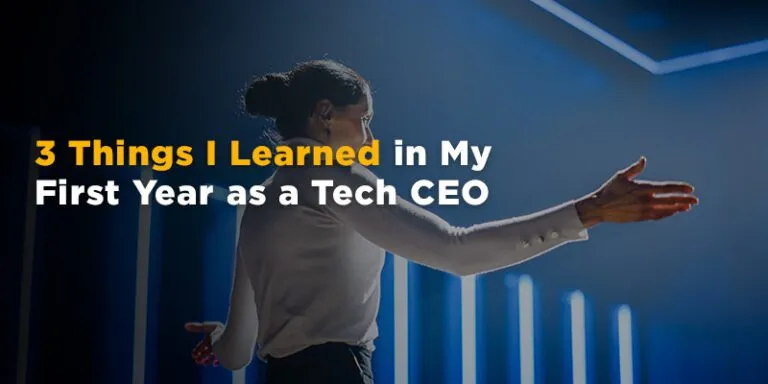3 Things I Learned in My First Year as a Tech CEO
Blog: Solutions Review - Business Process Management

As part of Solutions Review’s Contributed Content Series—a collection of contributed articles written by our enterprise tech thought leader community—Karl Chan, the CEO at Laserfiche, shares three things he’s learned in his first year as a tech CEO.
 When it comes to being the CEO of any company, there are a few things that will always be part of the job: bearing the responsibility for company successes (and failures), making difficult business decisions, leading big projects and teams, and being the face of the company, just to name a few. In my experience, however, there are a few things people don’t tell you when you take on the role and some lessons you may find yourself learning on the fly.
When it comes to being the CEO of any company, there are a few things that will always be part of the job: bearing the responsibility for company successes (and failures), making difficult business decisions, leading big projects and teams, and being the face of the company, just to name a few. In my experience, however, there are a few things people don’t tell you when you take on the role and some lessons you may find yourself learning on the fly.
I was the CTO and then president of a tech company for 25 combined years. When I made the leap to CEO last August, I thought, “How different can it be?” The answer: Much.
Different isn’t a negative. On the contrary, it’s been eye-opening and pleasantly challenging, and everything I’ve learned so far has made me a better leader. If you harbor aspirations for the top office, here are three lessons I’ve learned in my one-year tenure as a CEO.
1) The Art of Communicating
Communication is often classified as a “soft skill,” and this distinction may cause busy leaders to overlook its importance. They may think what worked in a previous role will work as a CEO or baseline public speaking prowess will make them master communicators. What I didn’t realize is that for a CEO, your responsibility isn’t just to keep your team informed or celebrate exciting new product features. As a CEO, you are your company’s lead storyteller—and storytelling matters.
We used to have a company newsletter with no named author, and while our talented marketing team poured time and energy into its contents, we always had a readership that hovered around 10 percent of the company. After sunsetting the newsletter, I started to write weekly articles on our Intranet, specifically authored by me and focusing on personal stories. I then invited various employees to write articles as well. Our articles that share personal stories have an average readership of 40-50 percent of the company, all because of their focus on storytelling.
The same goes for company all-hands meetings. Again, as a CTO, the technology team and I knew the same lingo and were interested in updates on the tools, technology, and policies that impacted our day-to-day. Now that I run company-wide high-level meetings, I try and craft narratives that will help people remember big messages. For example, for my first meeting as CEO, I used the thought experiment of the ship of Theseus as a framework to discuss the changes going on in our organization.
2) The Value of Transparency
One thing that surprised me is the hunger people have to know how their company is doing, and as a leader, being transparent with my team is very important to me. However, it’s important to distinguish an unorganized “info dump” from transparency with context and analysis. We conduct an employee survey after every all-hands meeting, and I’ve noticed that the results of those surveys by themselves didn’t paint a full picture. We have to provide the context around the data to really help people understand the results.
I learned that if I give out an unstructured list of data points or facts, 10 different people with 10 different roles at the company could interpret them in 10 different ways. As a leader, I have a responsibility to not just show data but to communicate the insights we’re pulling from the data, to be clear about why we pulled those insights, and to share the strategic “next steps” we’ve devised based on the data points. All of that context is what constitutes true transparency.
Honesty builds trust, and another key aspect of being transparent is to report the bad and the ugly in addition to announcing your wins. I have no problem sharing news of setbacks or falling short of expectations when those conversations were warranted. Sometimes, that means having frank conversations with my executive team, and sometimes, that means sharing the news with the entire company at an all-hands meeting. Clearly addressing setbacks not only increases trust among the team and sets the stage for learning and growing from those experiences.
Conclusions supported by cold, hard data usually result in measurable goals and clear action items. Instead of an amorphous directive like “increase sales,” sharing a more targeted goal like “increase sales by 3 percent in the next quarter” feels much more attainable. Transparency and connecting the dots between day-to-day tasks and larger company goals motivate employees to do their best because they see how their work supports the company and their colleagues.
3) Be the Chief Complain Officer
My background as a CEO is unusual in that I started at Laserfiche as a programmer and came up through the organization, eventually being named the CEO nearly three decades after my first day on the job.
Back when I started, when everyone else would go out to buy lunch, I’d stay behind to eat my pre-packed lunch, answering tech support questions and responding to every complaint. It was during this time that I was made aware of the difference between how we intended the software to be used and how it was actually used in the field. I learned how our users were pushing the boundaries of our software’s capabilities and about the real-world problems our software was solving. This gave me a foundational understanding of the impact a company can have on the world.
I still try to remain as close to the customer experience as possible, listening to all the complaints I can to gain a deeper understanding of what problems our users need us to solve for them. At our annual user conference, Laserfiche Empower, I spend time at the customer support booth, where our experts help advise our customers who are working through complicated problems using our software. I’ve had customers tell me how pleasantly surprised they were to find themselves troubleshooting with the CEO. Sitting with our customers as they solve their problems is the best way I know to truly understand how to lead our development team in creating tools that serve our customers’ needs.
Though I try to give every team member at Laserfiche a turn as Chief Complaint Officer, there aren’t always the best opportunities to do so. A good approximation is our dogfooding initiative, working to find solutions to our own internal processing problems using the Laserfiche software. This helps build customer empathy across every department.
Good Luck!
Leaders set the tone of a company’s culture. If you lead with honesty, diligence, and an open mind, you’re more likely to get the same back from your employees. As a CEO, I have an excellent team around me, and if you become a tech CEO one day, ensuring that smart people surround you is integral to long-term success.
The post 3 Things I Learned in My First Year as a Tech CEO appeared first on Best BPM Tools, Vendors, Software and BPMS.
